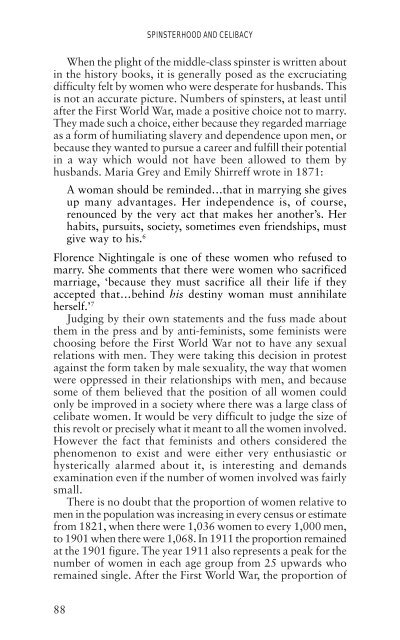The Spinster and Her Enemies - Feminish
The Spinster and Her Enemies - Feminish
The Spinster and Her Enemies - Feminish
You also want an ePaper? Increase the reach of your titles
YUMPU automatically turns print PDFs into web optimized ePapers that Google loves.
SPINSTERHOOD AND CELIBACY<br />
When the plight of the middle-class spinster is written about<br />
in the history books, it is generally posed as the excruciating<br />
difficulty felt by women who were desperate for husb<strong>and</strong>s. This<br />
is not an accurate picture. Numbers of spinsters, at least until<br />
after the First World War, made a positive choice not to marry.<br />
<strong>The</strong>y made such a choice, either because they regarded marriage<br />
as a form of humiliating slavery <strong>and</strong> dependence upon men, or<br />
because they wanted to pursue a career <strong>and</strong> fulfill their potential<br />
in a way which would not have been allowed to them by<br />
husb<strong>and</strong>s. Maria Grey <strong>and</strong> Emily Shirreff wrote in 1871:<br />
A woman should be reminded…that in marrying she gives<br />
up many advantages. <strong>Her</strong> independence is, of course,<br />
renounced by the very act that makes her another’s. <strong>Her</strong><br />
habits, pursuits, society, sometimes even friendships, must<br />
give way to his. 6<br />
Florence Nightingale is one of these women who refused to<br />
marry. She comments that there were women who sacrificed<br />
marriage, ‘because they must sacrifice all their life if they<br />
accepted that…behind his destiny woman must annihilate<br />
herself.’ 7<br />
Judging by their own statements <strong>and</strong> the fuss made about<br />
them in the press <strong>and</strong> by anti-feminists, some feminists were<br />
choosing before the First World War not to have any sexual<br />
relations with men. <strong>The</strong>y were taking this decision in protest<br />
against the form taken by male sexuality, the way that women<br />
were oppressed in their relationships with men, <strong>and</strong> because<br />
some of them believed that the position of all women could<br />
only be improved in a society where there was a large class of<br />
celibate women. It would be very difficult to judge the size of<br />
this revolt or precisely what it meant to all the women involved.<br />
However the fact that feminists <strong>and</strong> others considered the<br />
phenomenon to exist <strong>and</strong> were either very enthusiastic or<br />
hysterically alarmed about it, is interesting <strong>and</strong> dem<strong>and</strong>s<br />
examination even if the number of women involved was fairly<br />
small.<br />
<strong>The</strong>re is no doubt that the proportion of women relative to<br />
men in the population was increasing in every census or estimate<br />
from 1821, when there were 1,036 women to every 1,000 men,<br />
to 1901 when there were 1,068. In 1911 the proportion remained<br />
at the 1901 figure. <strong>The</strong> year 1911 also represents a peak for the<br />
number of women in each age group from 25 upwards who<br />
remained single. After the First World War, the proportion of<br />
88

















